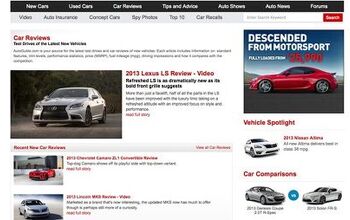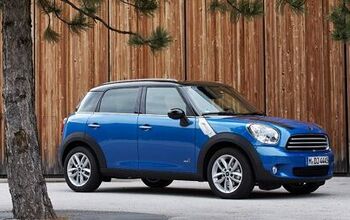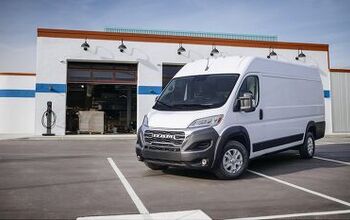2013 MINI Paceman Review – Video

If I didn’t know better, I’d think the serpentine cord of asphalt I’m shooting up into the hills outside Ponce, Puerto Rico was a one-way road. It’s so tight even a MINI feels, well… not very mini, and the reality of the situation hits me just as I’m trying to avoid an oncoming circa-1980 Toyota coupe from doing the same. Somehow managing not to kiss mirrors, I drop a wheel off the road and across a local’s front lawn, something that’s far from unusual here.
FAST FACTS
| 1. Compared to the regular MINI hardtop, the Paceman is over a foot longer, 4-inches wider and 4-inches taller. |
| 2. Both a 121-hp 1.6L 4-cyliner and a 181 hp turbocharged version of that engine are available, as well as a 208 hp JCW model. |
| 3. Paceman models start at $23,900 with Cooper S models at $27,500 or $29,200 with AWD. |
With a rainforest-esque canopy covering the route, and miles and miles of snaking blacktop ahead, few automakers build products better suited to these conditions.
The highway provides a different sort of adventure. With a surprising number of drivers setting their personal speed limit at well below the posted number and the concept of using the left lane for passing as foreign as I feel on this Caribbean island, the disproportionately high number of Mitsubishis and Suzukis are like moving pylons for my car, the new Paceman.
The latest in the growing MINI lineup, the Paceman is what the company calls the world’s first sports activity coupe.
WHAT THE HECK IS IT?
Get the Flash Player to see this player.
A negative side affect of the spunky British brand’s success, not to mention its uniform design direction, consumers are no longer sure which car is which, and it’s hard to blame them.
So what exactly is the Paceman and what makes it unique? In the basic sense it’s a two door Countryman (the brand’s first ever crossover). Alternately, it’s like a larger version of the traditional MINI hardtop – with an available AWD system.
There’s also the design. Perhaps the most masculine of the group, it borrows significantly from the Countryman up front with its flat-nose, while the black mesh grille adds more aggression. Moving rearward the design becomes unique, with a sloping roofline, sculpted rear shoulders and the first use of horizontal taillights (they’re really more square) on a MINI, helping to make it look wider, rather than taller.
MINI is up-front with the fact that, historically, American consumers have asked the brand for larger cars and AWD. The Countryman helped change that and as a result has become the brand’s second best selling vehicle overnight. That said, its no surprise MINI is now offering a second model that also fulfills the same list of consumer demands.
LESS MINI, IN CERTAIN WAYS
While continuing to look small it’s still noticeably larger than the standard hard-top, measuring four-inches taller, four-inches wider and a foot and a half more in length.
The added dimensions do come with more rear seat room, though it’s still cramped, and feels more so than the Countryman, despite an identical wheelbase. Amplifying that is the sloped rear roofline, which cuts out a half an inch of headroom.
MINI has done an amazing job at branding itself as a car company that puts a lot of interior space into a small package. The reality is that its cars aren’t actually terribly small (by European standards they’re the norm). They also aren’t terribly spacious inside, though the small quarters are likely part of the reason people think they’re diminutive in size.
That, and the way they drive.
FUN-TO-DRIVE, BUT AT WHAT COST?
The go-kart analogy is cliché but its not wrong either, right down to the suspension. Most go-karts, you see, don’t really have any.
MINIs are engineered to deliver driving enjoyment and this one is no different. Pitch it into a corner and it has loads of grip while the turbocharged Cooper S model we tested delivers plenty of torque for climbing up some incredibly steep grades.
Full power is rated at 181 ponies while torque sits at 177 lb-ft, though get full on the throttle and an overboost mode will deliver 15 lb-ft more. Front drive models with the stick shift can hit 60 in as little as 6.9 seconds, though our All4 AWD tester with the automatic is a touch slower at 7.6 seconds, MINI claims.
Base models are notably less impressive and come equipped with a 121 hp 1.6-liter 4-cylinder, offering tepid acceleration with a best of 9.7 seconds to 60 mph. Opt for the automatic transmission and it’s even worse at 10.8 seconds. AWD is not available on the base engine, which would likely struggle to move under the added weight.
The obvious plus-side to the entry-level engine is fuel economy, with a 35 mpg highway rating. Surprisingly, however, both the Cooper and Cooper S models achieve 27 mpg in the city, with the turbocharged car dropping to 32 mpg on the highway, or one tick less if you opt for all-wheel drive.
With most of our MINI testers usually coming equipped with a six-speed manual, it was nice to be reacquainted with the automatic, a gearbox that’s fast shifting and quick to drop gears, especially in sport mode.
Sport mode, an option, also stiffens up the steering and makes the throttle more responsive. And paired with the available fully-defeatable traction control makes it a genuine performance machine.
More softly sprung than most MINIs, the Paceman has very little body roll and a low stance (with less ground clearance than a standard MINI in fact), meaning it’s more car than crossover. It’s easy to understand why the body roll is so limited when the road gets rough – there’s very little play in the suspension. It’s not just a comfort issue either. Hit some uneven pavement in a corner and the car skitters across the lane making you feel like a rally car driver. It’s a mostly exciting experience, but with a touch of fear.
On the highway, some of the larger potholes we hit while dodging jalopies fully compressed the suspension. MINI really puts the bump in bumpstop.
ERGONOMICS EVOLVED
MINI hopes to attract buyers who are simply smitten with the car’s design. Chances are that same group will find equal favor with the interior layout, though we caution you to fully explore it first.
The brand’s toggle switch controls are not for everyone and take some getting used to. MINI is finally starting to acknowledge the error of its ways by removing the toggle switch window controls from the bottom of the center stack and replacing them with conventional buttons on the doors.
There’s far more wrong with MINI interior controls that that, however. A perfect example of the brand’s quirkiness are the seats, with height controls for the driver’s seat on the left side, forward and aft controls on the front, and the seatback angle adjuster on the right near the back of the seat. It’s also blocked by the armrest, so you have to move that up first.
FORM OVER FUNCTION
Under the guise of being a quasi utility vehicle the MINI may wear its mask well, but it’s a mask nonetheless. Rear cargo room is rated at 11.5 cu-ft which is enough for a decent amount of groceries, though packing for a trip (like we were on in Puerto Rico) revealed just how small that is, with our cameraman’s suitcase and tripod taking up all of the space, both rear seats then had to be used for our carry-on bags.
A smarter way to pack would be to drop the rear seats (there are just two, not a three-person bench) opening up a total of 38 cu-ft of space. That number sounds expansive, but isn’t. Even a Hyundai Accent offers more.
At least for its size, the rear hatch has a large opening that’s easy to load cargo in. It also opens and closes with little effort and it extends upward high enough that any 6-footer can stand underneath.
The available AWD system certainly helps bolster the Paceman’s utility credentials, though don’t think of it as much of an off-roader. In fact, it has less ground clearance than a conventional MINI hardtop, which helps explain why it handles so well.
As for the price it starts at a not un-reasonable $23,900 though Cooper S models quickly jump to $27,500 or $29,200 if you want AWD.
Those with cash to burn can even spec out a John Cooper Works model as well for the serious sum of $36,200.
THE VERDICT
Judged as a crossover, it may not excel, but that’s not likely to stop many from wanting to own a Paceman.
Being larger it already has a solid chance at winning over customers who may have rejected purchasing other MINI two-doors because they were too small. Added dimensions don’t give it much more interior room, but it’s sure to make some folks who are unsure about small cars a bit more comfortable behind the wheel.
Plus, it retains the brand’s attractive qualities of being unique and stylish; perhaps even more so than the rest of the lineup. Oh, and it’s still quite fuel-efficient and a ton of fun to drive too.
Putting those qualities together it’s not as surprising to learn that the second most cross-shopped car with the MINI hardtop is the BMW 3 Series (the first is the Prius). That said, it’s easy to see why MINI made the Paceman. In fact, it almost seems like the natural evolution of the modern MINI hardtop.
LOVE IT
- Unique style
- Fun to drive
- A less-mini MINI
LEAVE IT
- Cramped rear quarters
- Limited cargo space
- Frustrating interior controls
- Not exactly a bargain

With AutoGuide from its launch, Colum previously acted as Editor-in-Chief of Modified Luxury & Exotics magazine where he became a certifiable car snob driving supercars like the Koenigsegg CCX and racing down the autobahn in anything over 500 hp. He has won numerous automotive journalism awards including the Best Video Journalism Award in 2014 and 2015 from the Automotive Journalists Association of Canada (AJAC). Colum founded Geared Content Studios, VerticalScope's in-house branded content division and works to find ways to integrate brands organically into content.
More by Colum Wood































Comments
Join the conversation
I have a 2012 mini hardtop and really like it. However I am always making excuses for the rear seat. If this car drives like my mini and has a real backseat I may consider switching.
I would love to finally have a Mini that had a smooth ride. The Paceman is very attractive, I wouldn't mind one....however....meh....to the 1.6 liter, automatic...and when I run the A/C full blast constantly, will someone be available to push me up the fwy onramp, puh-leez??